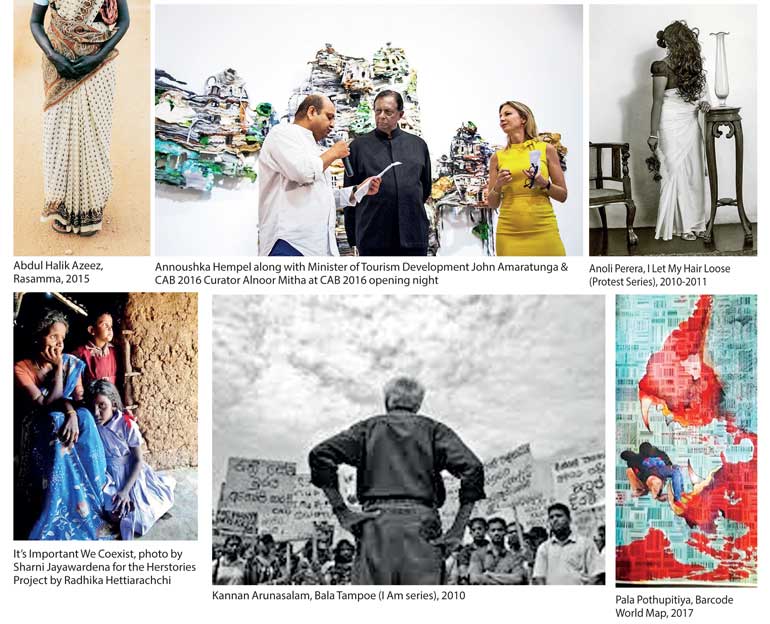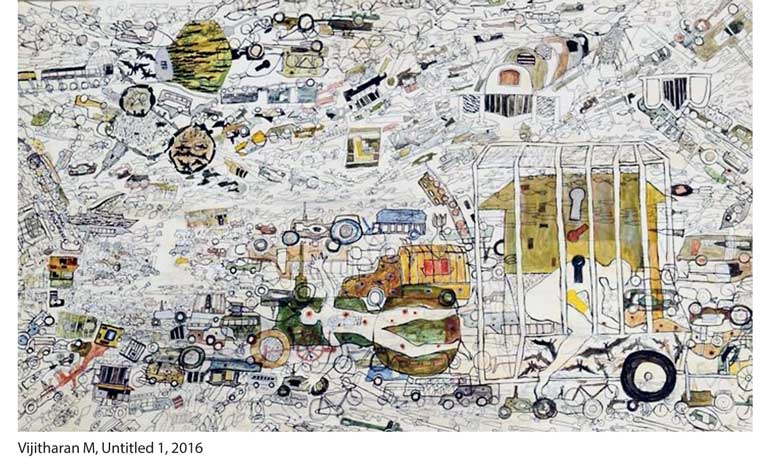Sunday Dec 21, 2025
Sunday Dec 21, 2025
Friday, 23 June 2017 00:00 - - {{hitsCtrl.values.hits}}


After 14 years in Sri Lanka, Annoushka Hempel will pack up house and soon be London bound again. While on the face of it she is ‘heading home’, things have not, quite purposefully, been neatly tied up at departure. Friendships persist and will bring her back to visit, but so will her decision to keep her commitment to the two well-known endeavours she founded back when she first arrived with her young family in Galle in the early 2000s.
This is specifically her continuing role as curator and director of Hempel Galleries, which now will, sans its official gallery spaces, evolve to function more modernly – taking on a pop up approach when her artist’s need it. And then there is her active leadership of the Colombo Art Biennale which she co-founded in 2009, and is functioning full steam ahead taking on its most prominent showcasing yet this August at the renowned Edinburgh Fringe Festival, and also very much in the planning stages for an ever strengthening and larger showing at its 5th edition set for 2018.
So, at her hard to imagine 50 years, Annoushka is taking to the millennial lifestyle of working virtually. It is a decision fuelled by the fact that distance not only makes the heart stay fond, but by her belief that firmer footing on the UK front will only add to furthering the underlying ethos that fuels her work – that Sri Lankan contemporary art needs due and exposure and heralding on the global stage. And, for those who have seen her interact with colourful and impassioned gathering of artists that walk in and out of her Barnes Place gallery-home, it is also evident that she is intertwined in a community of people who have too much caring and history to accept clean-cut endings.
Annoushka talks about what urged her from her early days in Sri Lanka as yoga teacher to becoming the well-known gallerist she now is. On trips exploring and learning of the ins and outs her new Sri Lankan home in those early days she often found herself in the studios and kitchens (acting as studios) of local artists. She found in them work that she wasn’t really seeing in the still limited art houses of Sri Lanka, and the discovery and potential of it all stoked her imagination and called her to consider a role that in hindsight made perfect sense.
With her heritage as the daughter of a sculptor mother, her study as SOAS art history and social anthropology graduate who had lead the research for African arts specialist Werner Gillon, and her understanding of PR and networks found on the London front, she decided to take a leap and put herself in the driver’s seat in setting up her namesake gallery. She recalls Hempel’s first exhibition, the first showing of work of a now leading voice in the contemporary Sri Lankan art scene and the first Sri Lankan to win the Hong-Kong based Sovereign Asian Art Award – Pala Pothupitiya. Not only did Pala’s natural talent for craftsmanship with a contemporary outlook cause her much excitement about the work (of which she still owns several pieces), but also she was greatly taken by the camaraderie of the three to four fellow artists who came to help Pala set up and cheer him on. Their genuine happiness in another’s success was something she wanted t be around more often.
Pala is one 15 artists whose work will be part of the CAB helmed contemporary Sri Lankan art showcase to be exhibited at the world’s largest arts festival – Scotland’s ‘Fringe’. This is the first comprehensive locally curated showing in the Fringe’s 70 year history and comes at a time when given both the festival’s banner year, and the global state of political and social upheaval, the Fringe looks to revisit its founding principle ‘to heal the wounds of war through the language of the arts’ – a conversation Sri Lanka is well-suited to contribute to.
Curating under the title ‘RETURN: in search of stillness’, Annoushka has selected artists from the CAB catalogue, starting from the biennale’s inception in 2009 up to present, who were up to both the challenge of creating under a theme that seeks to encapsulate feelings of catharsis, displacement, exit and stillness – emotions identified as focal points in Sri Lanka’s ongoing journey to move away from the continuing cycles of violence that have too long plagued it and move towards seizing the opportunities of stabilising its yet tenuous peace in order to achieve both healing and progress. It’s a big task, and on the curatorial front it requires courage in envisioning how works and perspectives that both complement and contrast can get an equal hearing within a shared space.
As part of ‘In search of stillness’, established artists such as internationally acclaimed live performance artist Venuri Perera, and pioneering feminist and colonial discourse artist Anoli Perera will present alongside emerging artists Kanesh Thabendran and Vijithiran M., both from Jaffna, who from their respective mixed-media and painting standpoints speak about what has gone missing, and the trauma of the end of the war.
To this artistic dialogue also enters photojournalist Abdul Halik Azeez whose work straddles both documentarian and artistic inclinations to speak of manifestations of community targeted that violence that persist in the post-war period. Next to him Al Jazeera and BBC featured filmmaker Kannan Arunasalam will present shorts, including those of vinyl collecting priest and, that speak to different shades and tones of Sri Lankan identities. Researcher Radhika Hettiarchchi will amplify the voices of Sri Lankan women from across the island through ‘Herstories’, while Anup Vega will harness energies for healing through his life arts installation informed through multi-religious rituals from Sri Lanka. Sujeewa Kumari will create her own space in which audiences can access nature and stillness within themselves.
Rounding off the visual arts program will be diaspora artists Rajni Perera’s take on the politics of cultural identity, and Maya Bastian’s new-media collage dealing with dissonance and reconciliation within shared family memories of the 80s. Acclaimed playwright and director Ruwanthie de Chickera will collaborate with British visual artist and academic David Cotterrell to look at contexts of objectification and distance. Finally, there is Alex Stewart, the British artist who has been visiting Sri Lanka since 1993, crafting storytelling exhibits that celebrate both the whimsical and hard-truths of Sri Lankan life and folklore to much local acclaim.
This showing at Fringe will be CAB’s most prominent international showing to date, preceded by ‘Serendipity Revealed’ at the Brunei Gallery SOAS in London in 2014, and a Pala special exhibit at the Saatchi Gallery in 2015. With ‘In search of stillness’ being hosted at the invitation of the founders of the coveted Summerhall, a ‘Fringe Firsts’ award-winning and top press-attended venue with a knack for spotting must-see and accolade deserving shows, there are high hopes for all participating and Sri Lanka’s diverse art talent pool at large to get its moment to step from the fringes to the global spotlight.
RETURN: in search of stillness, 2 August-24 September, will be hosted at Summerhall’s Sciennes Gallery, Edinburgh, Scotland. It is supported in large by the British Council Sri Lanka.